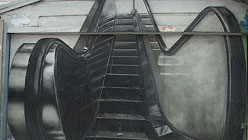San Francisco’s Mission District is home to a high concentration of street art, bearing witness to an artistic community as vibrant as it is diverse. A heady mix borrowed in equal parts from the Mexican muralistas, 1930s WPA murals, graffiti, skater graphics, hip hop, and the alternative comics that emerged in the 1960s and 1970s, the street art of the Mission reflects the concerns, aspirations, celebration, and anguish of a dynamic and vital neighborhood. Spark takes a tour through the Mission’s famous decorated streets.
The diverse background of Mission residents is staggering, encompassing every economic and social stratum — from loft-dwelling urban professionals to undocumented day laborers. Residents range from newly landed 20-somethings fresh out of college to families whose roots in the neighborhood run generations deep. Decades of changing demographics and diversity have created a kind of cultural laboratory that has produced more than 500 murals since the Mission mural movement began in the 1960s.
Balmy Alley, located off 24th Street’s bustling commercial strip, is a one-block stretch of fences and residential structures covered with a dynamic series of murals. The project dates back to 1972, with the work of Patricia Rodriquez and Graciela Carillo, who collectively came to be known as Las Mujeres Muralistas. Their project grew in 1984, when Ray Patlan led an initiative that resulted in 25 additional murals, connected through the common themes of celebrating the indigenous cultures of Central America and protesting U.S. intervention in the region. Since then, artists have continued to add to the project, making the alley an ongoing visual record of cultural and social developments.
The other major mural concentration in the Mission is Clarion Alley, a narrow passage that runs from Valencia Street to Mission Street, just south of 17th Street. Clarion has been a center of artistic activity and bohemian culture at least as far back as the early 1960s, when acclaimed minimalist composer Terry Riley occupied a warehouse space on Clarion. In 1992, inspired by Balmy Alley, a group of street artists came together to form the Clarion Alley Mural Project (CAMP). But whereas Balmy Alley grouped its murals together around a common theme, CAMP’s goals were social inclusiveness and aesthetic variety. CAMP works primarily with young artists — some are muralists, some are creating public work for the first time. CAMP has become something of a rite of passage for many artists who have gone on to establish themselves internationally.
The street art of the Mission District is available for viewing anytime. Guided tours can be booked through Precita Eyes Mural Arts and Visitor Center.
Array
Resources
- Array
- Array
- Array
- Array
- Array
Related Episodes
Mission District Street Art
The Mission District Street art segment was produced by Spark for This Week in Northern California.

